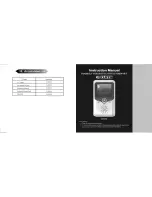
35
2
2
TEST 4 - Check Alternator
There are two methods of testing the alternator windings:
1. Measuring the winding resistance and comparing
them to the specifications.
2. Bypassing the Automatic Voltage Regulator (AVR).
Either one can be used, or they can be used in conjunction
with each other to confirm a diagnosis.
Measure Winding Resistance
Prior to measuring resistance, perform the following steps:
1. Set control panel system switch to
OFF
.
2. Remove the 15 Amp fuse..
3. Remove screws to gain access to the circuit breaker
and neutral connection
4. Disconnect the power wires 11 and 44 from the
circuit breaker.
5. Disconnect wires 22 and 33 from the (installer
supplied) neutral wire. Then separate wires 22 and
33.
6. Disconnect all the wires from the voltage regulator
Test Stator AC Power Windings
1. Set meter to measure Ohms.
2. Connect the test leads to stator wires #11 and #22
(Figure 14).
3. Measure the resistance and compare it to the
nominal resistance from the specifications listed
Section 4.
Figure 14
4. Connect the test leads to stator wires #33 and #44
(Figure 15).
Figure 15
5. Measure the resistance and compare it to the
nominal resistance listed in Section 4.
• A reading within the specifications listed is
acceptable.
• A reading of infinity or high resistance indicates
an opening in the power winding. Relace the
stator.
• A low reading indicates a shorted stator winding.
Replace the stator.
6. Connect one meter test lead to a proper ground on
the engine or alternator. Connect the other test lead
to the stator power winding.
• A reading of infinity should be measured.
• A reading other than infinity indicates a stator
winding shorted to ground. Replace the stator.
Check Stator Excitation Windings
The excitation wires may be colored (red and blue) or
numbered (#2 and #6). Colored excitation wires must
not
be
confused with the colored power wires. The excitation wires
were disconnected from the voltage regulator earlier in
Mesuring Winding Resistance
.
1. Set meter to measure Ohms.
2. Connect the test leads to the stator excitation wires
#2 and #6 (Figure 16).
Not
for
Reproduction
Summary of Contents for 040298
Page 23: ...19 1 1 N o t f o r R e p r o d u c t i o n...
Page 24: ...20 1 1 N o t f o r R e p r o d u c t i o n...
Page 29: ...25 2 2 N o t f o r R e p r o d u c t i o n...
Page 33: ...29 2 2 N o t f o r R e p r o d u c t i o n...
Page 36: ...32 2 2 N o t f o r R e p r o d u c t i o n...
Page 37: ...33 2 2 N o t f o r R e p r o d u c t i o n...
Page 43: ...39 2 2 N o t f o r R e p r o d u c t i o n...
Page 47: ...43 2 2 N o t f o r R e p r o d u c t i o n...
Page 50: ...46 2 2 N o t f o r R e p r o d u c t i o n...
Page 51: ...47 2 2 N o t f o r R e p r o d u c t i o n...
Page 55: ...51 2 2 N o t f o r R e p r o d u c t i o n...
Page 58: ...54 2 2 N o t f o r R e p r o d u c t i o n...
Page 66: ...4 N o t f o r R e p r o d u c t i o n...
















































